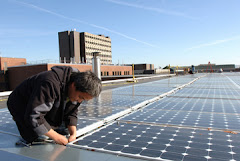The Obama administration is continuing research that began more than ten years ago on capturing the emissions from burning coal and storing the CO2 underground. Some environmentalists remain skeptical about the outcome, and uncertainties still exist as to the industrial feasibility, economic cost and legal aspects.
Secretary Chu Announces First Awards from $1.4 Billion for Industrial Carbon Capture and Storage Projects
Washington, DC (10/2/2009) — U.S. Energy Secretary Steven Chu today announced the first round of funding from $1.4 billion from the American Recovery and Reinvestment Act for the selection of 12 projects that will capture carbon dioxide from industrial sources for storage or beneficial use. The first phase of these projects will include $21.6 million in Recovery Act funding and $22.5 million in private funding for a total initial investment of $44.1 million. The remaining Recovery Act funding will be awarded to the most promising projects during a competitive phase two selection process.
The successful development of advanced technologies and innovative concepts that reduce emissions of carbon dioxide into the atmosphere is a key objective of the Obama Administration’s effort to help mitigate the effects of climate change. Carbon dioxide is a major greenhouse gas and contributor to global climate change.
The full report, including a list of large-scale industrial carbon capture and storage selections announced, is here.
A special issue of Science magazine (September 25, 2009) contains background information and scientific reports on carbon capture and sequestration. The scientific articles are preceded by the Editorial below:
Editorial: Carbon Capture and Sequestration
By Steven Chu, U.S. Secretary of Energy and Nobel Laureate in Physics
Overwhelming scientific evidence shows that CO2 emissions from fossil fuels have caused the climate to change, and a dramatic reduction of these emissions is essential to reduce the risk of future devastating effects. On the other hand, access to energy is the basis of much of the current and future prosperity of the world. Eighty percent of this energy is derived from fossil fuel. The world has abundant fossil fuel reserves, particularly coal. The United States possesses one-quarter of the known coal supply, and the United States, Russia, China, and India account for two-thirds of the reserves. Coal accounts for roughly 25% of the world energy supply and 40% of the carbon emissions. It is highly unlikely that any of these countries will turn their back on coal any time soon, and for this reason, the capture and storage of CO2 emissions from fossil fuel power plants must be aggressively pursued.
Read more here...
For more information, see the Dept. of Energy Web site.
There are other sides to CCS, as indicated in the articles below:
Refitted to Bury Emissions, Plant Draws Attention
The technology is certain to devour a substantial amount of the plant’s energy output — optimists say 15 percent, and skeptics, 30 percent. Some energy experts argue that it could prove even more expensive than solar or nuclear power.
And as with any new technology, even the engineers are unsure how well it will work: will all of the carbon dioxide stay put?
Environmentalists who oppose coal mining and coal energy of any kind worry that sequestration could simply trade one problem, global warming, for another one, the pollution of water supplies. Should the carbon dioxide mix with water underground and form carbonic acid, they say, it could leach poisonous materials from rock deep underground that could then seep out. Read the full report in the NY Times.
Clean coal? Obama making $2.4 billion bet
More funding for controversial ‘carbon capture and storage’ research
Read more here.
Carbon capture and storage -- Trouble in store
Politicians are pinning their hopes for delivery from global warming on a technology that is not quite airtight. See the report in the Economist, here.
Blackout: Heinberg on dwindling coal reserves and the siren song of “clean coal”
There isn’t nearly as much coal left as most people think. “Clean coal” will run down limited reserves even faster. If humanity doesn’t begin massive, sustained investment in renewable power sources immediately, civilization could be at risk before the end of the century. And that’s without considering the impacts of climate change.
Right now the U.S. is on the verge of a momentous gamble, as reflected in the ACES bill: betting that long-term emission reductions can be achieved via carbon capture and sequestration (CCS). ACES postpones serious domestic reductions for over a decade on the assumption (hope?) that CCS technology will mature and drop in price enough to enable the indefinite use of coal. See the report at Grist.
Carbon Recycling - An alternative to carbon capture and storage
Legally, there are concerns over whether CO2 transport and long-term storage present human or ecosystem related risks and who is ultimately responsible if a leak occurs. While progress is underway in some countries, no country has yet developed the comprehensive, detailed legal and regulatory framework that is necessary to effectively govern the use of CCS.
So why expensively transport and store the CO2 underground when it could be profitably recycled post-capture? Read more here.













